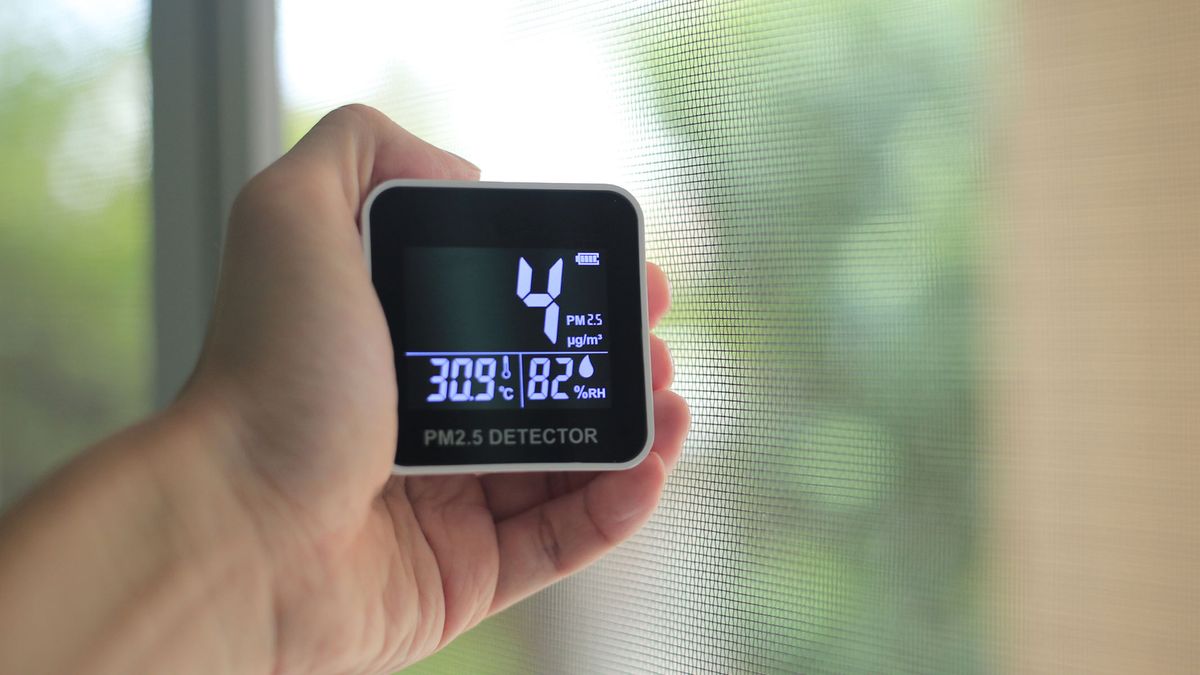How is air quality measured at home?
How to test the air quality in your home, according to experts.

Maintaining good indoor air quality is essential for health. Exposure to pollutants like particulate matter and ozone can lead to significant health issues, including respiratory diseases and heart disease. But how can you test the air quality in your home to ensure it is up to scratch?
There is no single way to measure airborne pollutants, Allen Rathey, director of the Indoor Health Council, a US-based organization dedicated to promoting healthy indoor environments, told Live Science by email. "Indoor air pollutants behave like an oil spill where oily particles spread into and permeate the environment," he said.
"To detect oil in water and effectively monitor oil spills, several types of sensors are used, including optical, conductivity, ultrasonic and electrochemical sensors. Similarly, once air pollutants are released into the ocean of indoor air, they require different detection methods," Rathey said. "For example, many consumer devices can detect solid airborne particles, but fewer detect gasses."
However, conducting complex indoor air quality tests is rather impractical and resource-intensive, Chloe Fellows, founder of Haze Environmental, a specialist air quality consultancy based in Worcestershire, England, told Live Science by email.
"High-quality monitoring of indoor air quality requires precise, professional-grade monitors, which can be out of reach for many households due to the cost and maintenance of such kit. Interpreting the data can also be difficult, which means it is often best left to someone with specialist knowledge, such as an indoor air quality consultant," Fellows said.
- Related: What is the Air Quality Index?
So how can you measure the air quality in your home without spending too much? You have to be selective. Pick equipment that measures the pollutants you are most concerned about, with enough precision to satisfy your needs and within the time frame that works best for you, Fellows told us.
For example, you can invest in an always-on electronic monitor that continuously tests and reports the levels of particulate matter, via an in-built display panel or by linking to a smartphone. Some devices also track temperature, humidity, carbon monoxide and carbon dioxide levels, to give you a more detailed snapshot of the air quality at any moment. Typically, these sensors detect and count solid airborne pollutants using a laser light-scattering technique. For measuring gasses, they often rely on light absorption or chemical reactions within the unit, according to the U.K. Environment Agency.
As we mentioned before, these household air quality monitors are not designed to give a complete picture of indoor air quality. Moreover, they may not provide accurate estimates of the pollutants they deem to detect. For example, air quality monitors may not be sufficiently sensitive or properly calibrated, and many devices get less accurate over time (most need to be replaced after one or two years). Also, air quality monitors can be sensitive to extreme temperatures and humidity, according to the U.S. Environmental Protection Agency (EPA).

In addition, "Some devices may not detect pollutants at harmful levels, therefore giving users a false sense of security," Fellows said, "which is why the low-cost consumer-grade monitors should be viewed with caution."
Carbon monoxide is a good example of such an elusive pollutant. It is a tasteless, odorless and colorless gas, and is usually emitted from gas furnaces or gas-burning stoves. Carbon monoxide is lighter than air, so monitors able to detect it should be placed high up, near the ceilings. Otherwise, they may not be able to pick up on it.
Which device should you choose, then? "Look for indoor air quality monitors that are RESET certified. This group tests and validates the performance of the monitors," Anthony Abate, an indoor air quality expert and vice-president and chief technology officer at AtmosAir Solutions, a sustainable indoor air purification and monitoring technology company in Fairfield, Connecticut, told Live Science by email. The goal of the RESET Air Standard is to ensure that the air quality data collected by a monitor is as trusted, actionable and relevant as possible.
The takeaway? Properly maintained air quality monitors can be a helpful tool in identifying some airborne pollutants, but they should not be treated as the sole source of air quality data or viewed as a substitute for good air cleaning habits.
For example, opening doors and windows is still one of the best ways to improve ventilation and allow the air to circulate naturally, diluting emissions and blowing pollutants away. Mechanical ventilation— using outdoor-vented fans, for example — can also remove air from a single room, while air-handling systems replace indoor air with filtered outside air at strategic points in the home. You could also consider investing in one of the best air purifiers, or a humidifier to increase moisture levels within the home to keep irritants like polluting particles at bay.
This article is for informational purposes only and is not meant to offer medical advice.

Sign up for the Live Science daily newsletter now
Get the world’s most fascinating discoveries delivered straight to your inbox.
Kerry is a freelance writer and editor, specializing in science and health-related topics. Her work has appeared in many scientific and medical magazines and websites, including Forward, Patient, NetDoctor, YourWeather, the AZO portfolio, and NS Media titles.
Kerry’s articles cover a wide range of topics including astronomy, nanotechnology, physics, medical devices, pharmaceuticals and mental health, but she has a particular interest in environmental science, cleantech and climate change.
Kerry is NCTJ trained, and has a degree Natural Sciences from the University of Bath where she studied a range of topics, including chemistry, biology, and environmental sciences.
